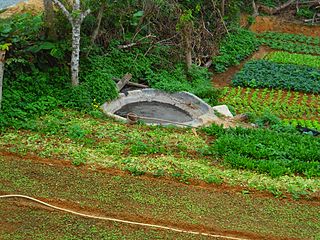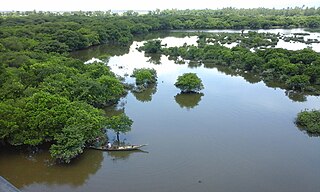
Compost is organic matter that has been decomposed in a process called composting. This process recycles various organic materials otherwise regarded as waste products and produces a soil conditioner.
Vegan organic gardening and farming is the organic cultivation and production of food crops and other crops with a minimal amount of exploitation or harm to any animal. Vegan gardening and stock-free farming methods use no animal products or by-products, such as bloodmeal, fish products, bone meal, feces, or other animal-origin matter, because the production of these materials is viewed as either harming animals directly, or being associated with the exploitation and consequent suffering of animals. Some of these materials are by-products of animal husbandry, created during the process of cultivating animals for the production of meat, milk, skins, furs, entertainment, labor, or companionship; the sale of by-products decreases expenses and increases profit for those engaged in animal husbandry, and therefore helps support the animal husbandry industry, an outcome most vegans find unacceptable.

A composting toilet is a type of toilet that treats human excreta by a biological process called composting. This process leads to the decomposition of organic matter and turns human excreta into compost. It is carried out by microorganisms under controlled aerobic conditions. Most composting toilets use no water for flushing and are therefore "dry toilets".

Night soil is a historically used euphemism for human excreta collected from cesspools, privies, pail closets, pit latrines, privy middens, septic tanks, etc. This material was removed from the immediate area, usually at night, by workers employed in this trade. Sometimes it could be transported out of towns and sold on as a fertilizer.
Human waste refers to the waste products of the human digestive system and the human metabolism, namely feces and urine. As part of a sanitation system that is in place, human waste is collected, transported, treated and disposed of or reused by one method or another, depending on the type of toilet being used, ability by the users to pay for services and other factors.

Organic fertilizers are fertilizers derived from animal matter, animal excreta (manure), human excreta, and vegetable matter. Naturally occurring organic fertilizers include animal wastes from meat processing, peat, manure, slurry, and guano.

Ecological sanitation, commonly abbreviated as ecosan, is an approach to sanitation provision which aims to safely reuse excreta in agriculture. It desires to "close the loop" mainly for the nutrients and organic matter between sanitation and agriculture. One of the aims is to minimise the use of non-renewable resources. When properly designed and operated, ecosan systems provide a hygienically safe system to convert human excreta into nutrients to be returned to the soil, and water to be returned to the land.
Green waste, also known as "biological waste," is any organic waste that can be composted. It is most usually composed of refuse from gardens such as grass clippings or leaves, and domestic or industrial kitchen wastes. Green waste does not include things such dried leaves, pine straw, or hay. Such materials are rich in carbon and considered "brown wastes," while green wastes contain high in concentrations of nitrogen. Green waste can be used to increase the efficiency of many composting operations and can be added to soil to sustain local nutrient cycling.
An aerobic treatment system or ATS, often called (incorrectly) an aerobic septic system, is a small scale sewage treatment system similar to a septic tank system, but which uses an aerobic process for digestion rather than just the anaerobic process used in septic systems. These systems are commonly found in rural areas where public sewers are not available, and may be used for a single residence or for a small group of homes.

An arborloo is a simple type of composting toilet in which feces are collected in a shallow pit and a fruiting tree is later planted in the fertile soil of the full pit. Arborloos have a pit like a pit latrine but less deep, a concrete slab, superstructure to provide privacy and possibly a ring beam to protect the pit from collapsing.

Urine diversion, also called urine separation or source separation, refers to the separate collection of human urine and feces at the point of their production, i.e. at the toilet or urinal. Separation of urine from feces allows human waste to be treated separately and used as a potential resource. Applications are typically found where connection to a sewer-based sanitation system is not available or areas where water supplies are limited.

Manure is organic matter, mostly derived from animal feces except in the case of green manure, which can be used as organic fertilizer in agriculture. Manures contribute to the fertility of the soil by adding organic matter and nutrients, such as nitrogen, that are utilised by bacteria, fungi and other organisms in the soil. Higher organisms then feed on the fungi and bacteria in a chain of life that comprises the soil food web.

A dry toilet is a toilet that operates without flush water, unlike a flush toilet. The dry toilet may have a raised pedestal on which the user can sit, or a squat pan over which the user squats in the case of a squat toilet. In both cases, the excreta falls through a drop hole.
Resource recovery is using wastes as an input material to create valuable products as new outputs. The aim is to reduce the amount of waste generated, therefore reducing the need for landfill space and also extracting maximum value from waste. Resource recovery delays the need to use raw materials in the manufacturing process. Materials found in municipal solid waste can be used to make new products. Plastic, paper, aluminium, glass and metal are examples of where value can be found in waste.
Sustainable Organic Integrated Livelihoods or SOIL is an American nonprofit developmental aid organization co-founded by Sasha Kramer and Sarah Brownell in 2006. Its goal is to develop integrated approaches to the problems of poverty, poor public health, agricultural productivity, and environmental destruction in Haiti. SOIL’s efforts have focused on the community-identified priority of increasing access to ecological sanitation, where human wastes are converted into compost. More than 20,000 Haitians are currently using SOIL ecological sanitation toilets.

Hügelkultur is a horticultural technique where a mound constructed from decaying wood debris and other compostable biomass plant materials is later planted as a raised bed. Adopted by permaculture advocates, it is suggested the technique helps to improve soil fertility, water retention, and soil warming, thus benefiting plants grown on or near such mounds.

A urine-diverting dry toilet (UDDT) is a type of dry toilet with urine diversion that can be used to provide safe, affordable sanitation in a variety of contexts worldwide. Through the separate collection of feces and urine without any flush water, many advantages can be realized, such as odor-free operation and pathogen reduction by drying. While dried feces and urine harvested from UDDTs can be and routinely are used in agriculture, many UDDTs installations do not apply any sort of recovery scheme. The UDDT is an example of a technology that can be used to achieve a sustainable sanitation system. This dry excreta management system is an alternative to pit latrines and flush toilets, especially where water is scarce, a connection to a sewer system and centralized wastewater treatment plant is not feasible or desired, fertilizer and soil conditioner are needed for agriculture, or groundwater pollution should be minimized.

Reuse of excreta refers to the safe, beneficial use of animal or human excreta, i.e. feces and urine. Such beneficial use involves mainly the nutrient, organic matter and energy contained in excreta, rather than the water content. Reuse of excreta can involve using it as soil conditioner or fertilizer in agriculture, gardening, aquaculture or horticultural activities. Excreta can also be used as a fuel source or as a building material.

Container-based sanitation refers to a sanitation system where toilets collect human excreta in sealable, removable containers that are transported to treatment facilities. This type of sanitation involves a commercial service which provides toilets and delivers empty containers when picking up full ones. The service transports and safely disposes of or reuses collected excreta.
















